The honest truth about how to divide perennials
Do your eyes glide over the advice to ‘divide perennials’ in spring and autumn?
I always used to think that dividing perennials was for perfect gardeners. My relaxed attitude to gardening meant I could skip such suggestions. I was wrong.
And I worried that if I dug up a plant and split it, I would damage it. The plant might die.
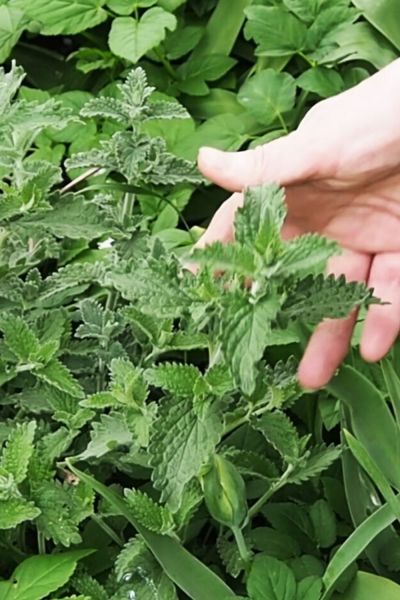
We divided this Nepeta Six Hills Giant last autumn. It was so entrenched that at one point, we needed an axe to get it out of the ground. But here it is shooting up very happily. Excuse the horrendous ground elder around the edges. Removing it is on my ‘to do’ list.
And I was wrong about that, too. In fact, a plant is very unlikely to die after being divided. Plants want to survive. Provided you take a few simple precautions, they will happily go back in the soil and start spreading again.
Even if you cut across a root, the plant will survive providing there is enough extra root around it. And there will be. I promise. By the time plants need dividing, they have usually trebled in volume. You will have plants to spare.
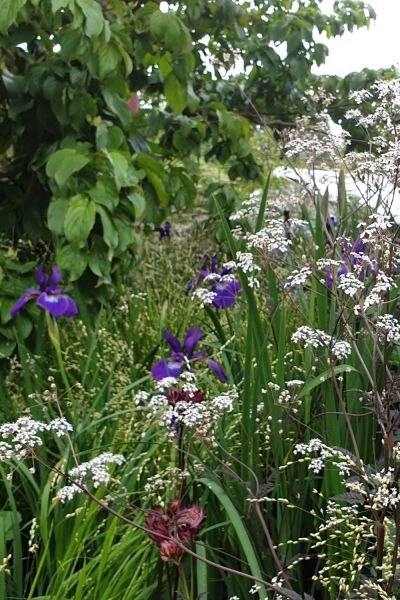
These Iris sibirica will take over the border if they’re not lifted and divided every few years. The frothy white Anthriscus ‘Ravenswing’ is a short lived perennial, so it will die off and need renewing every year or so.
Why you really do have to divide perennials
Many perennial plants – those which come back year after year – spread. You plant one plant. Over two or three years, it expands, growing new corms, tubers, rhizomes or roots under the ground, all around the original plant.
Then the original plant dies off. So you have a large circle of plants with a bald patch in the middle. This is then colonised by weeds and self-seeding plants. I love self seeders, so this is another reason why I haven’t worried too much.
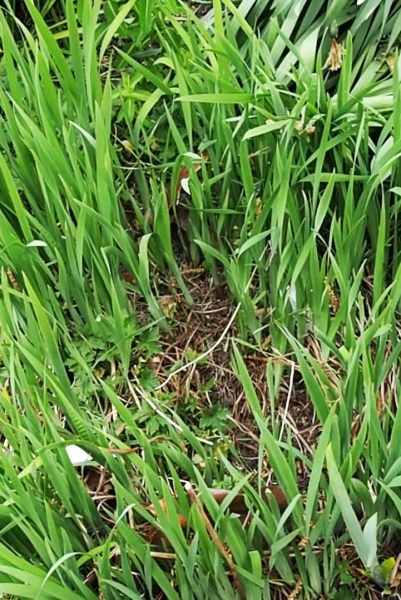
This Siberian iris has been in for about 10 years and it has spread. Note the bald patch in the middle, now being colonised by weeds. There is also a geranium in there and the two have intermingled.
However my borders are now an illustration of John Lennon’s saying ‘life is what happens while you’re making other plans.’ They are, frankly, a muddle. There are clumps of plants invading other clumps of plants and bald patches full of weeds.
Because some perennials are thugs. Their relentless desire to take over territory makes them the Genghis Khan of plant world. So when you buy other plants, they can disappear under the relentless march of day lilies, iris sibirica, phlomis and Japanese anemone.
In contrast, shrubs and roses stay where you planted them. They might get big – even very big. But they won’t go invading the rest of the garden, suppressing precious things you planted.
When to divide perennials
You can divide perennials in spring or autumn. If you do it in the summer or the winter, you’ll probably subject the plant to too much hot dry weather or cold, wet soil. Either will stress it.
And don’t divide plants when they’re flowering. I divide irises just after they’ve flowered, which is June (yes, even I divide irises or I would have nothing else in the garden!). But all the other plants can be divided in spring or autumn/fall.
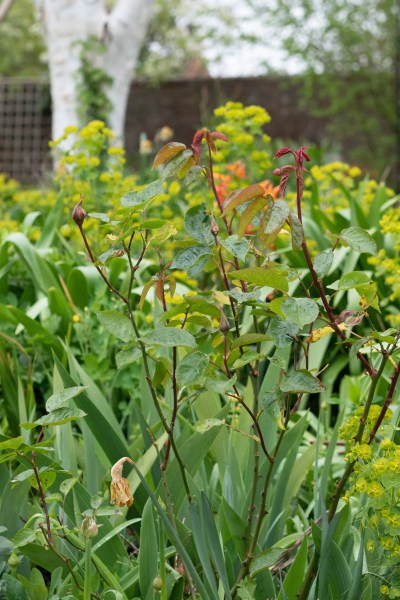
April is a good time to divide perennials – just as the rose foliage is emerging. This clump of bearded iris is encroaching on this rose, but I will wait until it’s flowered to divide it.
And that’s about all you need to know about when to divide perennials. If you look up advice on specific plants, some experts advise spring over autumn or the other way around. Although some of that advice seems to be inconsistent.
So, if you’re an imperfect gardener like me, just avoid dividing perennials in summer or winter.
My mistake, over the years, has been to think ‘it’ll be better to wait until spring/autumn.’ In gardening it is never better to wait. Because plants go on growing.
How to divide perennials
Firstly, you simply dig them up. Our ground has been very hard recently, so I watered a clump of Siberian irises before trying to dig them up.
I poked my spade in. But the Siberian irises have been there for years. They had no intention of coming out without a fight.
So I got Mr Middlesize to dig them up. He thought I was digging them up to throw them away. So as the plants came out of the ground he shook them vigorously to dislodge the soil around the roots and hurled them over his shoulder.
By the time I noticed this harsh treatment, the Siberian irises lay in an ignominious pile on the lawn. This is not what dividing perennials looks like on the Alan Titchmarsh video.
However, it hasn’t done the Siberian irises any harm at all. They come from Siberia, after all (do they?).
So the first honest truth about how to divide perennials is this. Prepare for lots of huffing and puffing to get some of them out of the ground. And don’t worry about hurting them. You’re much more likely to hurt yourself (see here for advice on preventing back and knee pain when gardening.)
When we divided our Nepeta Six Hills Giant last autumn, Mr Middlesize eventually took an axe to one of the clumps to get it out of the ground. The Nepeta are now re-planted, re-invigorated and bursting with new shoots.
Tease the roots apart gently
Forgive me for laughing at this point. It is a laugh of desperation. Titchmarsh et al can no doubt tease roots apart. He can do many things I can’t. But the instruction for us humbler mortals should be ‘wrestle the roots apart’.
If that doesn’t work, you are advised to use a spade. You chop neatly down, dividing the clump of plant into several smaller plants, all about the size they would be if you were buying them in a 3 litre pot in a garden centre.
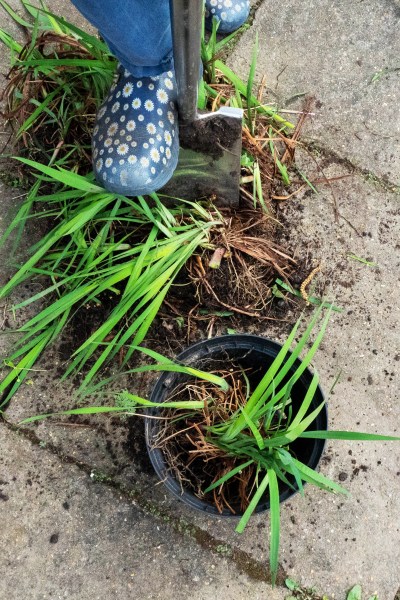
Not all perennials are as tough as Iris Sibirica but be prepared for a bit of a fight. To estimate the size of the clump you’re cutting off, aim for something that would fill a 3L pot if you bought it from new.
In fact, you place your spade carefully where you want to cut. You use your foot to jam down the spade.
Nothing happens. You are left wobbling on top of a clump of Siberian irises that have no intention of dividing. Eventually you jump off the spade before you fall off. Someone else in the household tries. That doesn’t work either.
You can also use a knife, say the experts. So we used a knife to cut through a very small amount of root. It wouldn’t go through the main clump but we made some headway on the outside.
By combining the three methods, we eventually manage to separate three iris clumps from the main plant. Two thirds of the iris stayed solidly stuck together.
At some point in all this I realised my trousers had split up the back. But I cut that bit from the video.
Replant immediately
I really wanted to go for a lie down at this point, but all the advice says ‘re-plant immediately.’
Treat the plants as if you had just bought them. Water them well. Check how far apart they need to be when planted. According to the internet, Siberian irises need to be 8″-12″ apart, so I returned the three small clumps to the space where there had been a large circle with a bald patch.
Add fertiliser
I added a few handfuls of blood, fish and bone fertiliser, as suggested by experts. The dog started eating from the top of the soil.
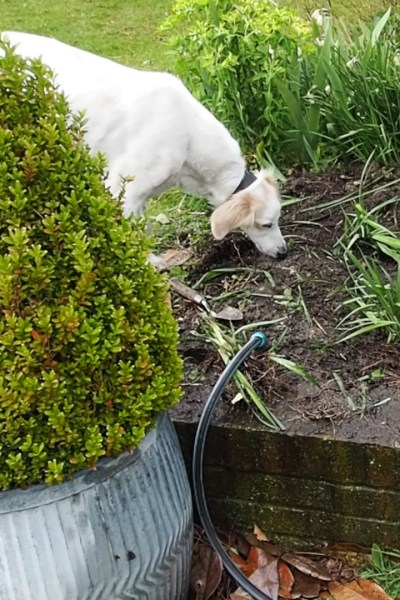
Add fertiliser, such as blood, fish & bone before re-planting the divided plants. Work quickly if you have a dog, as they love blood, fish and bone.
Water well
This helps the plants get established. It also washes the remains of the blood, fish and bone fertiliser into the soil, which stops the dog eating it.
If you have a very dry spell, you probably need to carry on watering the newly planted plants until their roots get properly established.
Which perennials need dividing?
There are a huge number of perennials which need dividing every few years. If you stay on top of it, you’ll probably find it easier than I did.
Perennials to divide include plants that clump up, like ornamental grasses, Siberian irises, phlomis and asters (symphyotricum). A friend of mine has just been grappling with dividing heleniums ( I think she had to jump off a wall onto the spade to get the roots to slice apart. I do not recommend this approach).
The ‘divide perennials’ list includes plants with rhizomes, such as irises or cannas. Plants with tubers, such as day lilies, also need dividing from time to time.
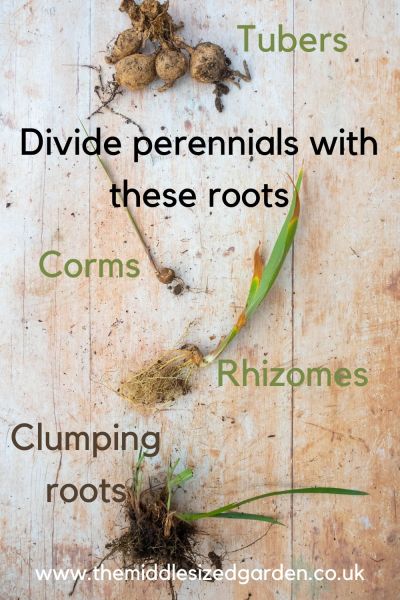
Perennials which need dividing include day lilies, asters (symphyotricum), ornamental grasses, irises and more – generally any which have the above root systems.
The general principle for all the different types of plants is the same. Dig them up. Divide them with any implement that will work. Don’t worry about cutting across one or two roots. Replant immediately with some fertiliser and a good watering.
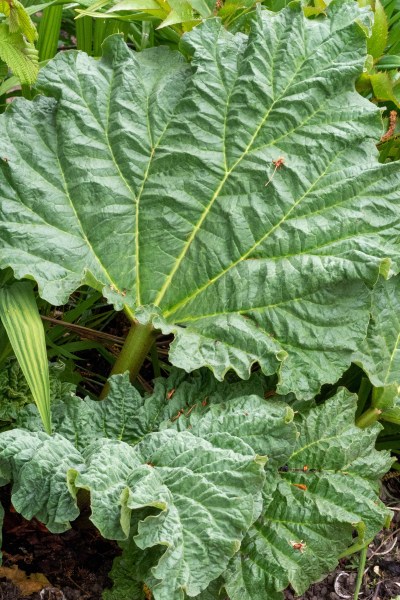
In the veg patch, rhubarb, strawberry plants and artichokes will need dividing from time to time.
Don’t divide…
There are some plants that come into the ‘divide perennials’ list but which experts don’t agree on. For example, some people suggest you divide peonies. Others don’t. None of my peonies spread, so I don’t see the need to divide them.
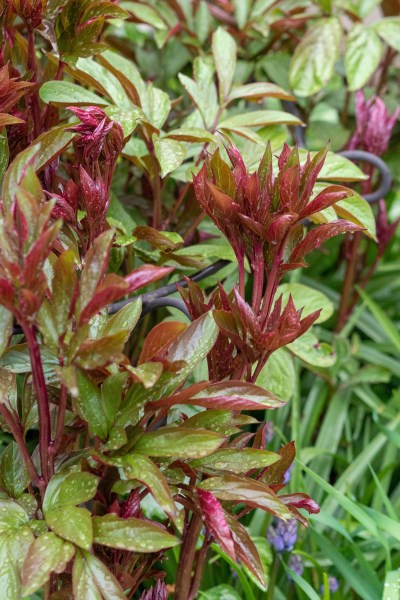
This peony was planted by my predecessor over 20 years ago. It hasn’t spread so I haven’t divided it. But please say if you think I should!
I suggest you follow own instincts on this one. If a plant has spread out into a circle with a bald patch in the middle and is taking over other plants, lift and divide it.
And, of course, if you’re trying to fill a large border inexpensively then plants that spread are the key to easy successful gardening. Plant those perennials and let them fill your empty gaps. You may not have to divide perennials for several years.
I am just warning you that the day will come. Arm yourself with a range of implements, a strong friend and a stiff gin.
I sometimes think that dividing perennials is one of the jobs that makes people sell their homes because the ‘garden is getting too much for them.’ Let me recommend finding a professional gardener. Pay them properly for their expertise. Even then, it will be cheaper than moving.
What to do with the remaining plants
You will probably be left with a half to two-thirds of the clump, rhizomes or tubers. You can give them to friends, but they themselves may be clearing out their more thuggish plants.
There may be a community border near you who would like them. Or you can pot up the plants and donate them to charity plant sales. Just remember to pick out any weed roots and label the plants.
Otherwise, you may have to throw them away. I am not entirely sure whether they will compost well, as I suspect the plants will grow through your veg peelings and grass cuttings. But provided you keep cutting the foliage off and covering them with more garden waste, they will eventually give up and turn into garden compost.
The Complete Guide to Garden Privacy
Just in case you’re interested in improving your garden privacy or creating a secret garden feel, may I mention my book The Complete Guide to Garden Privacy? It’s available in paperback in 10 countries or Kindle in 13 countries from Amazon or as a PDF download for those who want to read on a tablet or pc but don’t use Kindle.
Pin to remember how to divide perennials
And do join us every Sunday morning for tips, ideas and inspiration for your garden.
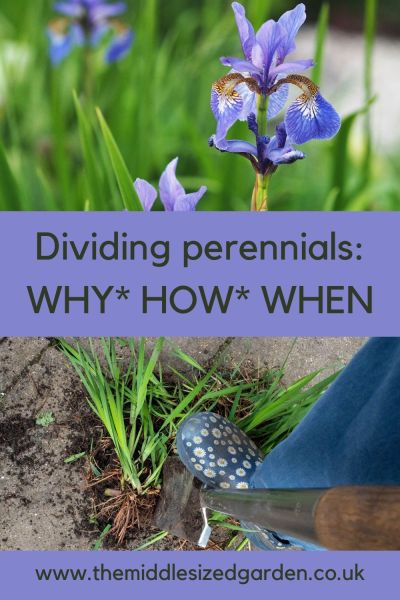
























Had to laugh about the dividing bit! I remember watching Monty dividing a miscanthus once. He casually stuck the spade in and it split like a knife in butter – ha, ha! Methinks someone got that ready prepared for him! I have just lifted and divided an overgrown miscanthus and my feet will need soaking in a bucket of ice later!! Jumping up and down on the spade, whilst trying not to trample my daffodils underfoot, using an old bread knife to saw apart with the every trusty mini axe at the ready! Got there in the end-only an hour or so later. Now onto the nepeta…….
Oh, the nepeta! I think Mr Middlesize broke a tool trying to get the nepeta out and divided. So good luck!
I use an old pruning saw i keep just for this kind of job
Excellent!
Found this blog by chance, how true! I’ve just had to divide a Crista Fern that is about 10 years old. Nearly killed myself and my entire body weight (which is considerable) jumping on the spade with both feet had no effect whatsoever. Took the wood saw to it in the end!
I’m wishing we’d thought of the wood saw!
Just came across your article by chance and found it very helpful! Thank you!
I just love your blog, but this has to be one of the best. Showing warts & all really helps to give us novices confidence. WELL DONE YOU.
Thank you!
I’ve only ever divided to get more but I keep an old saw for the job. You are so right about the wobbling on top of a spade nonsense, never mind that old silly of using two forks…..
As someone else commented, either here or on YouTube, not all of us have 2 forks, or if we do, they’re very different sizes. I did think of trying to do the two forks thing for the video, but my spirit failed me and both my forks are very different sizes as one is mine and the other is his, and we are very different heights.
The best thing I did was to subscribe to The Middlesize Garden – it is a great joy on a Sunday morning in lockdown to see the latest post appear in my inbox. Stay safe Alexandra and thank you!
Thank you so much!
Dividing perinnials: thank you, how true! I’ve had to take an electric saw to an ornamental grass before now, and that was before I managed to ‘tease’ from the ground
I was thinking some kind of machinery might be useful for future lifting and dividing. Chain saw definitely a good idea.